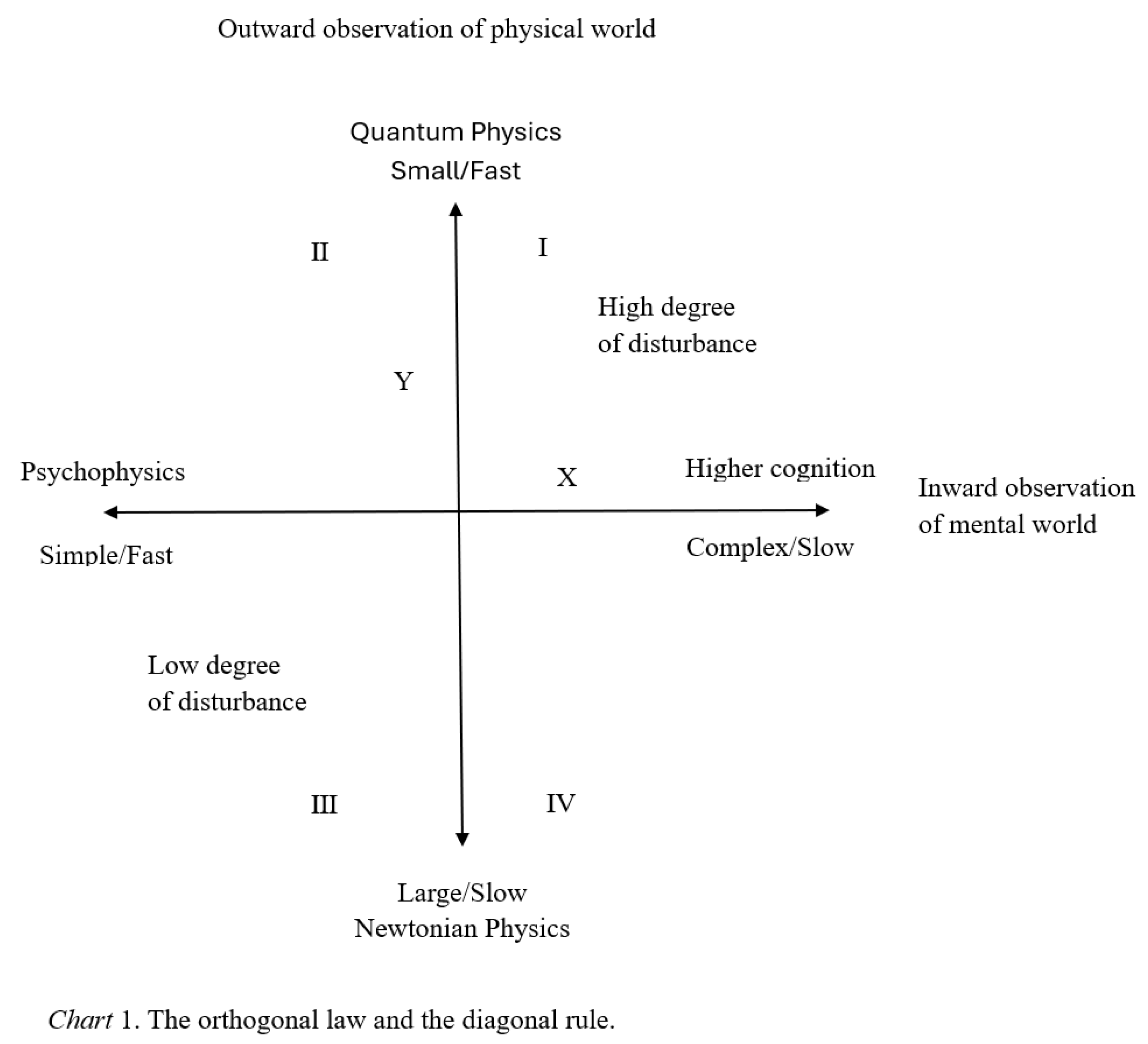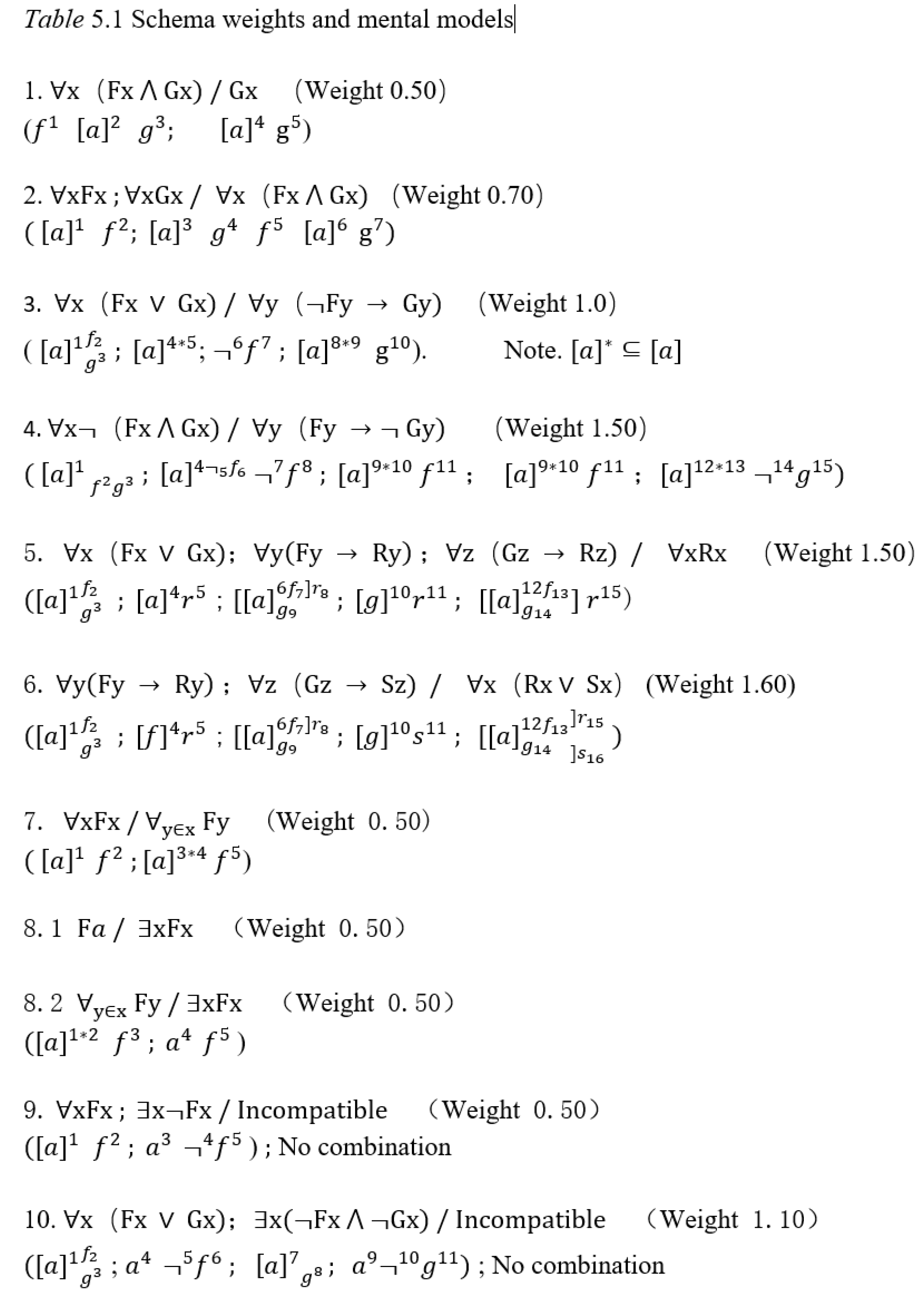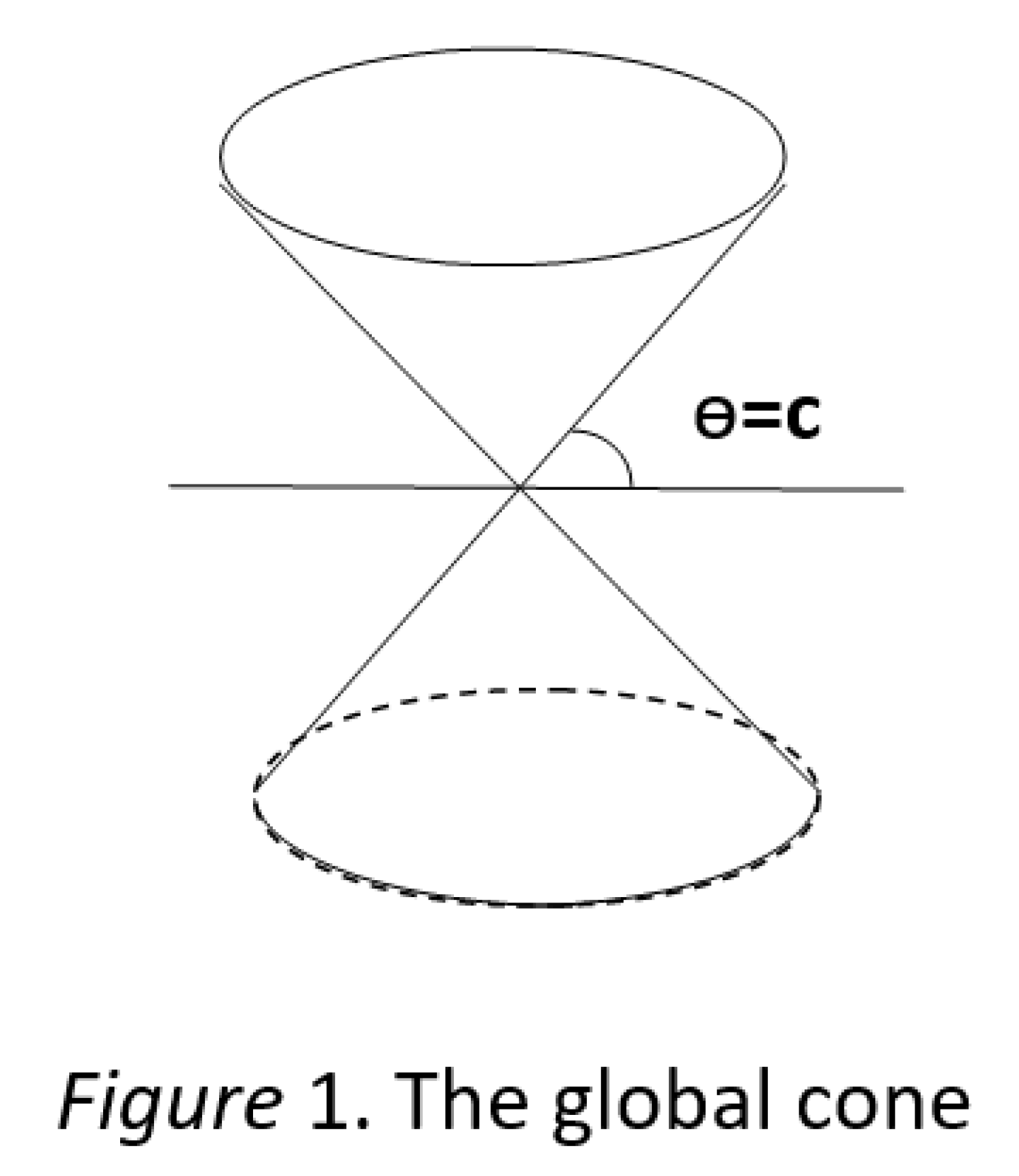Submitted:
15 May 2024
Posted:
15 May 2024
Read the latest preprint version here
Abstract
Keywords:
1. Introduction
2. Theoretical Controversies and the Gauge Structure
2.1. Reasoning is One of the Core Capacities of Human Cognition
2.2. Historical Controversies and Debates
2.3. Gauge Structure
3. An Empirical Puzzle and the Quantum Theoretic Solution
3.1. An Empirical Puzzle
| Some of the plastic beads are not red, or | (Premise 1) |
| None of the plastic beads are red | (Premise 2) |
3.2. Failed Mental Metalogic and the Quantum Lightening
3.4. A Set of New Questions
4. Why Do We Need a Quantum Model?
4.1. The Directness of Observations
4.2. Types of Experimentations

4.3. The Orthogonal Law and the Diagonal Rule
5. The Wavefunction and the Measurement Problem
5.1. Reasoning Dynamics: The U-Procedure
5.2. Logic Charge and Cognitive Field
5.3. Hesitation, Spin, and Dynamic Phase
5.4. The U-Procedure and the R-Procedure
5.5. Mental Energy

5.6. The Yes/No Type Measurement
6. The R-Procedure and a Solution of the Measurement Problem
6.1. The Measurement Problem
6.2. Stochastic Sampling
7. Gauge Symmetries and Gauge Transformations
7.1. The Gauge Invariance
7.2. The Global Gauge Symmetry
7.3. The Local Gauge Symmetry
7.4. The “Man vs. Men” Problem
8. The Language Cones and the Relativistic Phase Function
8.1. The Language as an Invariant
8.2. Interval and the Global Cone

8.3. The Proper Language Cones and the Individual Differences

8.4. Wittgenstein and the Language Game

9. General discussion
9.1. An Outline of the Contributions
9.2. The Directions for Future Work
References
- J. Forder (1975), The language of thought. Harvard University Press.
- M. D.S. Braine (1978). On the relation between the natural logic of reasoning and standard logic. Psychological Review, 85: 1-21. [CrossRef]
- L. J. Rips (1983). Cognitive processes in propositional reasoning. Psychological Review, 90(1), 38. [CrossRef]
- P.N. Johnson-Laird (1983). Mental Models. Cambridge University Press.
- Holyoak, K.J. and Glass, A. (1975). The role of contradictions and counter examples in the rejection of false sentences. Journal of Verbal Learning and Verbal Behavior. 14, 215-239. [CrossRef]
- Y. Yang, M. D. S. Braine, and D. O’Brien (1998). Some empirical justifications of a mental predicate logic. Chapter 12, in M.D.S. Braine and D.P. (Eds.), Mental Logic. Mahwah, NJ: Lawrence Erlbaum Associates.
- Yang, Y., Bringsjord, S., and Bello, P. (2006). Mental possible world mechanism: A new method for analyzing logical reasoning problems on the GRE. Journal of Experimental and Theoretical Artificial Intelligence. Vol. 18 No. 2 157-168.
- Van der Henst, J-B, Yang, Y. and Johnson-Laird, P.N. (2002). Strategies in sentential reasoning. Cognitive Science, 26, 425-468. [CrossRef]
- Yang, Y. and Johnson-Laird, P.N. (2001). Mental models and logical reasoning problems in the GRE. Journal of Experimental Psychology: Applied. 7 (4), 308-316.
- M.D.S. Braine and D.P. (Eds., 1998), Mental Logic. Mahwah, NJ: Lawrence Erlbaum Associates.
- P. N. Johnson-Laird and R. M. J. Byrne (1991), Deduction. Mahwah, NJ: Lawrence Erlbaum Associates.
- O'Brien, D.P., Braine, M.D.S., & Yang, Y. (1994). Propositional reasoning by mental models? Simple to refute in principle and in practice. Psychological Review, 101,711-724.
- P.N. Johnson-Laird, Ruth M. J. Byrne, and Walter Schaeken (1994). Why models rather than rules give a better account of propositional reasoning: A reply to Bonatti and to O’Brien, Braine, and Yang. Psychological Review 101 (4), 734-739.
- Braine, M.D.S., O'Brien, D.P., Noveck, I.A., Samuels, M.C, Lea, R., & Yang, Y. (1995). Predicting intermediate and multiple conclusions in propositional logic inference problems: Further evidence for a mental logic. Journal of Experimental Psychology: General, 124, 263-292.
- Ray. S. S. Jackendoff (1990). Semantic structure. MIT Press, Cambridge, Mass.
- Philip Johnson-Laird (2006/2008). How we reason. Oxford University Press Inc. New York.
- Yang, Y. and Bringsjord, S. (2003). Some initial empirical justifications for mental metalogic: The case of reasoning with quantifiers and predicates. In R. Alterman & D. Kirsh (Eds.): The Proceedings of the Twenty-fifth Annual Conference of the Cognitive Science Society, 1275-1280. Mahwah, NJ: Lawrence Erlbaum Associates.
- David Bailin and Alexander Love (1986/2019). Introduction to gauge field theory. CRC Press.
- Yang, Y. and Johnson-Laird (2000). Illusions in quantified reasoning: How to make impossible seem possible, and vice versa. Memory & Cognition. 28 (3), 452-465.
- Yang, Y. and Johnson-Laird, P.N. (2000). How to eliminate illusions in quantified reasoning. Memory & Cognition, 28 (6), 1050-1059. [CrossRef]
- Yang, Y., Zhao, Y., Zeng, J., Guo J., Ju, S. and Bringsjord, S. (2005). Some empirical justifications for the universalness of the mental logic/model paradigm. In B. Bara, L. Barsalou, & M. Bucciarelli (Eds.), Proceedings of the Twenty-Seventh Annual Conference of the Cognitive Science Society, 2399-2404. Mahwah, NJ: Lawrence Erlbaum Associates.
- R. Feynman, R. B. Leighton, and M. Sands (1971). The Feynman lectures on physics, Vol. 3. Addison Wesley.
- Allen Newell and Herbert Simon (1972). Human Problem solving. Echo Point Books & Media, LLC.
- R. Feynman (1971). Quantum electrodynamics. Basic Books.
- C. N. Yang (2014). The conceptual origins of Maxwell’s equations and gauge theory. Physics Today, November, 2014. [CrossRef]
- von Neuman (1955/1983), The Foundations of Quantum Mechanics. Princeton University Press, Princeton, New Jersey.
- R. Penrose (2004), The Road to Reality: A Complete Guide to the Laws of Universe. Random House Inc., New York.
- Bell, John and Machover, Moshe (1977). A Course in Mathematical Logic. North Holland Publisher.
- P. A. M. Dirac (1930/1958), Principles of Quantum Mechanics. Oxford University Press, Pearson Education Inc. New York.
- D. H. Griffel (1981/2002), Applied Functional Analysis. Dover Publications, Inc. Mineola, New York.
- Y. Yang (2024). The revised Schrödinger equation as a solution of measurement paradox: A unified model of the U-procedure and R-procedure. Under review, Annals of Mathematics, Princeton.
- Feynman, R. (1985/2006). QED, the strange theory of light and matter. Princeton University Press. Princeton, New Jersey. [CrossRef]
- Bringsjord S. and Yang, Y. (2006). Human reasoning is heterogeneous – as Jon Barwise informed us. Journal of Experimental and Theoretical Artificial Intelligence. Vol. 18, No. 2, 117-119.
- Yang, Y. (2006). Toward a mental decision logic of the small-grand problem: Its decision structure and.
- arithmetization. In R. Sun and N. Miyake (Eds.), Proceedings of the Twenty-Eighth Annual Conference of the Cognitive Science Society, Mahwah, NJ: Lawrence Erlbaum Associates.
- Savage, Leonard (1954/1972). The foundations of statistics. Dover Publications.
- Kahneman, Daniel (2011). Thinking, fast and slow. Farrar, Straus and Giroux. New York, New York.
- Osborne, Martin and Rubinstein, Ariel (1994). A course in game theory. MIT Press.
- Camerer, Colin (1999). Behavioral game theory. Princeton University Press. Princeton, New Jersey.
- Lee, T. D. (1988). Symmetries, asymmetries, and the world of particles. The University of Washington Press, Seattle.
| Experimental Characteristics | |||
| Disturbance | Low Macro-world | High Micro-world | |
| Observation | |||
| Outward | Slow / Large | Fast / Small | |
| Inward | Fast / Simple | Slow / Complex | |
Disclaimer/Publisher’s Note: The statements, opinions and data contained in all publications are solely those of the individual author(s) and contributor(s) and not of MDPI and/or the editor(s). MDPI and/or the editor(s) disclaim responsibility for any injury to people or property resulting from any ideas, methods, instructions or products referred to in the content. |
© 2024 by the authors. Licensee MDPI, Basel, Switzerland. This article is an open access article distributed under the terms and conditions of the Creative Commons Attribution (CC BY) license (http://creativecommons.org/licenses/by/4.0/).





